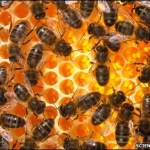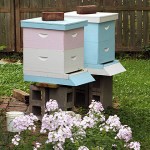beekeeping
Varroa mites can be highly destructive to bee colonies and are a big concern for beekeepers. They get inside honeycombs where they lay eggs and feed on the bee pupae. When the adult bees are released from their cells, so are the mites, which then go on to lay more eggs. Bees that live with these mites are usually smaller and prone to a disease known as deformed wing virus. The presence of the mites and the disease can decimate an entire hive.
Image of Varroa mite on a honeybee from Wikipedia
Dr. Francis Ratnieks (University of Sussex, Brighton) observed 42 honeybee colonies and discovered…
Our garden bees, photographed yesterday evening:
As you may have noticed, in painting our hives we've eschewed the standard hive whitewash in favor of pleasing pastels.
But we've got nothing on the hive art produced by other beekeepers on the web. Below the fold is a selection of my favorites:
(source)
(source)
(source)
(source)
(source)
(source)
(source)
(source)
(source)
What am I doing this summer?
Good question. I'm teaching Integrative Biology 496: Introduction to Beekeeping.
If you are a University of Illinois student and would like to learn about the biology of Apis mellifera and how to manage a small apiary for honey or just for fun, please consider this 8-week class. Enrollment is capped at 22 in order to maintain a reasonable student to hive ratio.
The class website is here.

